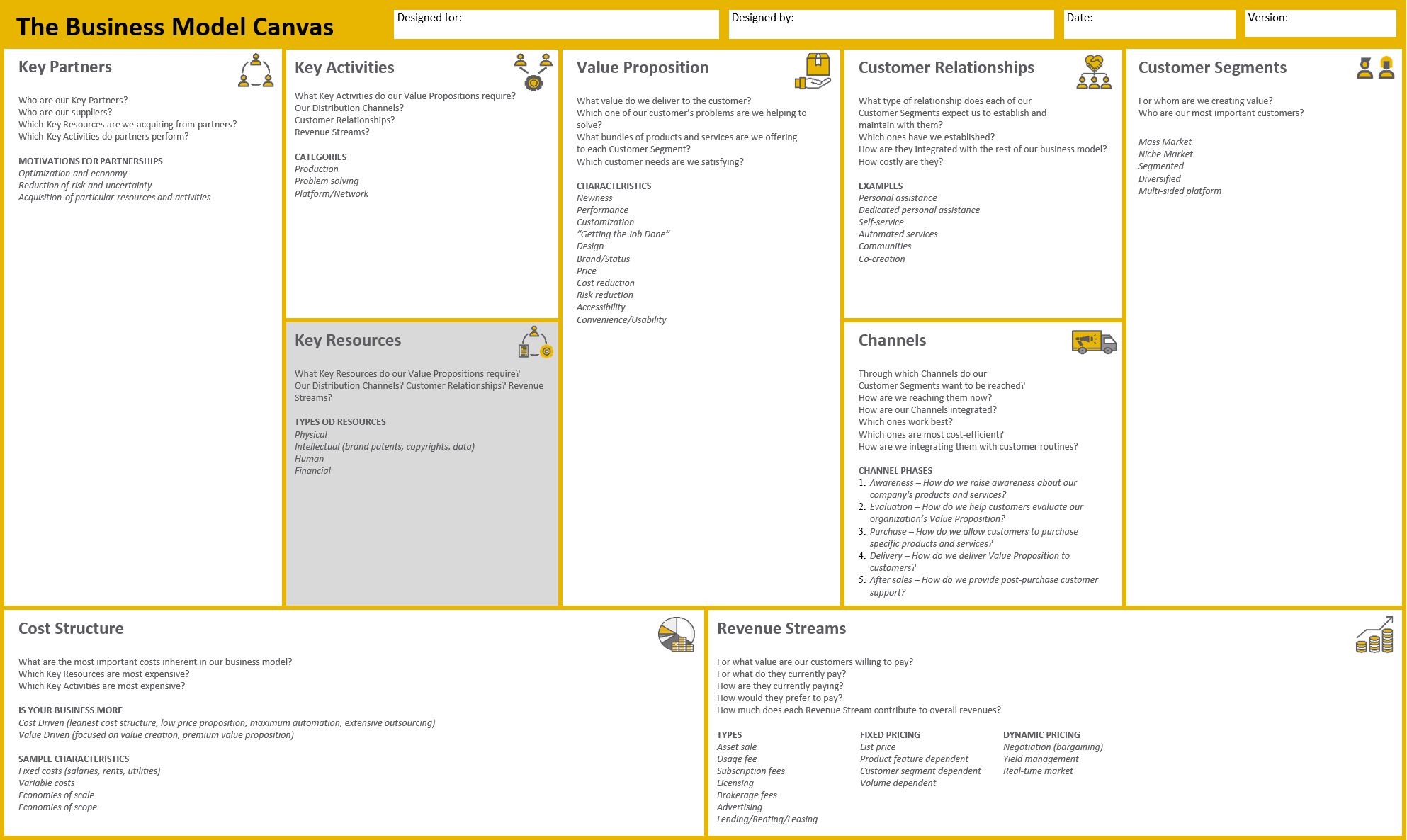Module 7
KEY RESOURCES
The purpose of this module is to help you understand what the Key Resources of a business model canvas are, and how you can work with them in your business plan (option, categorization, development, etc).



Key resources
Introduction
Every business model requires Key Resources. Your resources allow your enterprise to create and offer a Value Proposition, reach markets, maintain relationships with Customer Segments, and earn revenue. Different Key Resources are needed depending on the type of business model. Key resources may be physical, financial, intellectual, or human. Key resources can be owned or leased by the company or acquired from key partners.
Purpose
The purpose of this module is to help you understand what the Key Resources of a business model canvas are, and how you can work with them in your business plan (option, categorization, development, etc).
Learning Outcomes
After the completion of this module the learner will be able to:
-
- Understand what the Key Resources are;
- Comprehend the importance of Key Resources in a business model;
- Distinguish among the different types of Key Resources;
- Evaluate which Key Resources create the Value Proposition.
Keywords
-
- Key Resources
- Physical resources
- Intellectual resources
- Human resources
- Financial resources
- Customer segments
- Revenues
- Value Proposition
Theoretical background

A brief definition
A resource is an economic or productive factor required to accomplish an activity, or as means to undertake an enterprise and achieve a desired outcome.
Three most basic resources are land, labour, and capital. Other resources include energy, entrepreneurship, information, expertise, management, and time.
Key resources are the main inputs that your company uses to create its value proposition, service its customer segment and deliver the product to the customer. These are the most important things you need to have for your business model to work. These are the main assets that your company requires to create the end product, and these are usually differentiated from the key resources being utilized by your competitors. Key resources deal with the operational end of the business spectrum and define what kind of materials you need, what kind of equipment is required and the types of people you need to employ. This aspect plays a direct role in bringing your value proposition to life for your chosen customer segment and it defines the minimum you need to have to deliver to your customers.
In the Business Model Canvas, we only include those resources that make you unique compared to your competitors in the market.
Types of Key Resources
Key resources may be categorized into four main types:
-
- Physical;
- Intellectual;
- Human;
- Financial;
Physical Resources
Physical assets are tangible resources that a company uses to create its value proposition.
-
- These could include equipment, inventory, buildings, manufacturing plants and distribution networks that enable the business to function.
Retailers rely heavily on physical resources.
This aspect of business planning can be one of the costliest. It is therefore important for an entrepreneur to realistically assess all the required needs before making any purchases.
Intellectual Resources
These are non-physical, intangible resources.
-
- These could be the brand, patents, IP, copyrights, and even partnerships. Customer lists, customer knowledge, and even your own people represent a form of intellectual resource.
Intellectual resources take a great deal of time and expenditure to develop. Once developed, they can offer unique advantages to the company. They are increasingly important components of a strong business model.
Human Resources
Employees are often the most important and yet the most easily overlooked assets of an organization. This is particularly the case for companies in the service industries or for companies with activities that require a great deal of creativity and an extensive knowledge pool, where human resources, such as customer service representatives, software engineers or scientists, are pivotal. Every enterprise requires human resources, but people are particularly prominent in certain business models.
-
- For example, human resources are crucial in knowledge-intensive enterprises and in the creative industries.
The success of an organization is heavily reliant on the talent and strength of its employees. Strong team members may be recruited using a variety of methods. Staffing agencies and executive search firms specialize in placing talent at all levels within every industry. An alternative is to find employees through referrals from individuals whose judgment is trusted.
Financial Resources
The most important element in starting a business is funding. Even the most basic business incurs a multitude of start-up costs, including registering a business name, obtaining a business telephone line, etc.
-
- Financial resources may be obtained from a variety of sources, the easiest being from the personal accounts of the company’s founder. Alternatively, loans and lines of credit may be granted from financial institutions, friends and relatives, private investors and even the government. In addition, many grants are offered from private and public sources to entrepreneurs across all demographics. The financial resource includes cash, lines of credit and the ability to have stock option plans for employees.
All businesses have key resources in finance, but some will have stronger financial resources than others, such as, for example, banks which are based entirely on the availability of this key resource.
Other types of resources
The changing situation in the business world has triggered the appearance of additional types of resources:
-
- Educational Resources
Perhaps the greatest thing an entrepreneur can do when establishing a new business is to gain as much education as possible. By understanding the competition and gaining an in-depth knowledge of their industry, entrepreneurs will be better prepared to make smarter decisions regarding the direction their firm should take.
-
- Emotional Resources
Starting a business can be an extremely stressful endeavour for an entrepreneur to undertake. To maintain their sanity and to remain motivated, it is important that entrepreneurs have a supportive team that can give them inspiration, support and guidance as needed. This team may be composed of family and friends, together with a mentor or a professional group (or association).
Examples and Good practice
Key Resources based on the type of business
Key resources are the strategic assets an enterprise needs to have in place, to a greater or more targeted degree than the competition.
The Business Model Canvas proposes three core business types:
-
- Product,
- Scope,
- Infrastructure.
These three core business types tend to have similar types of Key Resources.
Product driven businesses have a differentiated product of some sort.
Scope driven businesses create some synergy around a particular Customer Segment.
Infrastructure driven businesses achieve economies of scale in a specific, highly repeatable area.
Good practices – VISA cards
VISA is a technology company providing payment solutions to banks globally. VISA itself does not provide financial assistance or lines of credit to customers. Instead, it provides banks and other financial institutions with an “Open Loop Payments Network” that provides a medium of communication and sharing of information between different companies across industries.
VISA provides value to cardholders by giving them a safe, secure and convenient way to make transactions. Merchants are able to provide their customers with added convenience when they accept VISA cards and banks charge fees for the use of the card, as well as transaction fees and late payment fees.
VISA does this through utilizing its key resources such as the global processing infrastructure that the company has built over many years. This infrastructure consists of geographically dispersed processing centres that are linked to each other and which are programmed to minimize redundancy. VISA operations focus heavily on managing and maintaining this infrastructure because it is key to providing VISA customers with security, convenience, speed, and efficiency.
Product Driven Businesses
These are companies that focus all their functions on the creation and sale of a product. This product has unique characteristics and a customer segment willing and eager to purchase it. Key resources for these businesses are intellectual and human, since these organizations typically have intellectual property and expertise in their particular industry and niche market.
Example: Rovio, the creator of the famous mobile game called Angry Birds, is one such example of product driven business.
Scope driven businesses
These are dedicated to provide a value proposition to a particular customer segment. These businesses possess key resources in their well-developed intelligence about their target customer segment, an established set of processes and, in some cases, infrastructure such as specialized service centres.
Example: an organization aiming to specialize in being the IT provider to all Law firms within an area is a scope driven business.
Infrastructure driven businesses
These, as the name suggests, achieve profitability through leveraging their developed and implemented infrastructure. The telecommunications industry invests heavily in developing the telecommunications infrastructure in a country and then reaps the rewards for years with only minor investments to keep their systems updated.
Retailers are also infrastructure driven businesses because they depend primarily on their established infrastructure to sustain their profitability in the long-term.
References and External Links
-
- Denis Oakley’s, Key Resources in the Business Model Canvas, www.Denis-Oakley.com
https://www.youtube.com/watch?v=hQAhEEkddKQ&feature=emb_logo - What Are The Key Resources Needed To Deliver The Value Proposition?
https://www.denis-oakley.com/business-model-canvas-course/key-resources/ - How do I use the Key Resources building block of the Business Model Canvas?
https://strategyzer.uservoice.com/knowledgebase/articles/1194367-how-do-i-use-the-key-resources-building-block-of-t - The 20 Minutes Business Plan: Business Model Canvas Made Easy
https://www.alexandercowan.com/business-model-canvas-templates/#Step_7_of_10_Key_Resources
https://www.youtube.com/watch?v=hQAhEEkddKQ&feature=emb_logo - Key Resources Building Block in Business Model Canvas
https://www.cleverism.com/key-resources-building-block-in-business-model-canvas/ - 5 Resources You Need to Succeed to Start a Business
https://smallbusiness.chron.com/5-resources-need-succeed-start-business-23.html - A List of Requirements Prioritization Techniques You Should Know About
https://www.businessanalystlearnings.com/blog/2016/8/18/a-list-of-requirements-prioritization-techniques-you-should-know-about - https://quizlet.com/latest
- http://www.businessdictionary.com/definition/resource.html
- Denis Oakley’s, Key Resources in the Business Model Canvas, www.Denis-Oakley.com
Copyright @2021 – businessmodels.eu

